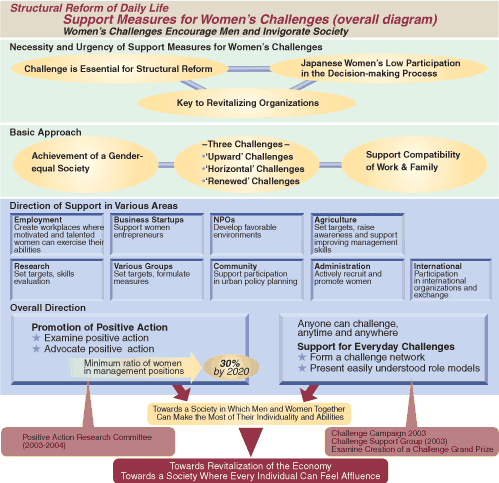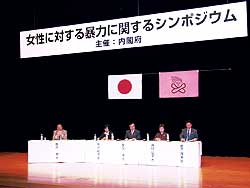![]()
Measures to Support Women's Challenges
In accordance with Prime Minister Koizumi's instructions in January 2002 to provide further insights, the Council for Gender Equality submitted its opinion paper to the Prime Minister and the other concerned ministers in April 2003 regarding important matters for promoting women's challenges in various fields as a part of encouraging structural reforms in people's daily lives.
Expecting that women having leading positions will increase to at least 30% of all the leaders by the year 2020, this opinion paper recommends that the government encourage voluntary efforts in various fields and to provide proper environments for one-stop information/network services for supporting women's challenges.
In June 2003, the Headquarters for the Promotion of Gender Equality decided to push ahead with the said opinion paper, such as actively recruiting female workers into the public sector prior to the private sector.
The Cabinet Office set up the Panel on Challenge Support Network " to discuss on a proper comprehensive information system for supporting women's challenges. The Cabinet Office also established the Positive Action Panel " to mainly work on legal matters for implementing proper positive actions in various fields.
Overall View of Women's Challenges

Promotion of the Appointment of Women to National Advisory Councils and Committees
With regard to the ratio of female members of national advisory councils and committees, based on the decision "Promotion of the appointment of women to national advisory councils and committees" adopted by the Headquarters for the Promotion of Gender Equality in August 2000, the Government is pressing ahead with measures to achieve the goal of a 30% participation rate as early as possible before the end of 2005. The Gender Equality Bureau of the Cabinet Office conducts regular annual surveys on the status of women's participation in national advisory councils and committees, and according to the survey of September 30, 2003, the ratio of female members stood at 26.8%, marking a remarkable increase over the 25.0% reported in the survey of September 30, 2002.
The Government makes use of various opportunities to request cabinet ministries to cooperate towards achieving this goal before the end of 2005 by actively appointing female members.
Promotion of the Appointment of Women to National Advisory Councils and Committees
Based on "Guidelines concerning enlargement of the recruitment and the promotion of femele national public officers" formulated by the National Personnel Authority, each cabinet ministry has formulated a Plan to enlarge the recruitment and the promotion of female officers" setting out targets to be achieved by FY2005, and all cabinet ministries have been making a united effort to push ahead with measures to this end.
In May 2003, the National Personnel Authority conducted the 2nd survey on the status of measures being implemented in line with each ministry's plan. This survey showed, in terms of recruitment, 9 ministries/agencies (32.1% of the total 28 surveyed ministries/agencies) hired more female officials compared with the previous fiscal year from Level I exam successful candidates; 14 ministries/agencies (50.0%) employed more female officials from Level II exam successful candidates; 13 ministries/agencies (46.4%) hired an increased number of female officials from Level III exam successful candidates. On the other hand, in terms of promotion 19 ministries/agencies (67.9%) have more female officials at section-chief level; 14 ministries/agencies (50%) at assistant-director level; and 5 ministries/agencies (17.9%) at associate-director or higher level. While government ministries/agencies tend to increasingly appoint female officials to higher positions in general, promotion of female officials to the executive position is not sufficient. Most ministries have pointed out that job transfers with relocation or stereotyped perceptions among government officials prevent the appointment of female officials to higher positions. It is necessary to properly address these problems.
Measures to Eliminate Violence against Women
Violence against women in the form of spousal violence, sexual crimes, prostitution, sexual harassment, stalking behavior and so forth, comprises a major infringement of women? human rights, and it is an important issue to overcome in the formation of a gender-equal society.
In addition to establishing a foundation from which to foster social awareness of the issue and eliminate violence against women, the government of Japan has been comprehensively promoting a wide range of measures to address different forms of violence.
- (1)Enforcement of "the Law for the Prevention of Spousal Violence and the Protection of Victims"
- The law provides for protection orders as well as spousal violence counseling and support centers and etc.
- Protection Orders
A protection order is a measure ordered by a court upon petition from a victim against the victim's spouse who is the assailant. The order provides for two kinds of measures; an order to prohibit the approach that prohibits the spouse from approaching the victim for a period of six months; and an order to vacate that requires the spouse to vacate the domicile that the spouse shares as legal home with the victim for a period of two weeks. According to statistics by the Supreme Court, 3,272 petitions for protection orders were received during the period following enforcement of the law on October 13, 2001 up until the end of November 2003, and orders were issued in 2,582 of these cases. The average period of time required before an order is issued was 11.2 days. 
About 400 participants from all over Japan attended the "Symposium on Violence against Women." - Spousal Violence Counseling and Support Centers(SV Centers)
Prefectural governments have their Spousal Violence Counseling and Support Centers at their women's counseling offices or other appropriate facilities. At present, 103 SV Centers all over Japan are providing services such as consultation and counseling, temporary protection for victims and accompanying family members, and providing various kinds of information. From April 2002 to the end of November 2003, SV Centers throughout Japan handled a total of 65,166 consultations. - Enlightenment and Training
The Cabinet Office has been actively conducting public relations activities via public relations magazines, websites and others in order to provide a wide spectrum of information on the actual condition of spousal violence, systems to relieve victims and others. The Cabinet Office also provides training sessions for counselors, holds conferences for prefectural officials in charge of spousal violence, and provides the necessary information and best practices and so forth.
- (2)Campaign for Eliminating Violence against Women
-
The headquarters for the Promotion of Gender Equality conducts a campaign for eliminating violence against women for two weeks from November 12 to 25 each year. The campaign consists of the enforcement of various measures, such as the utilization of the symbol for the elimination of violence against women adopted by the Cabinet Office in 2002.
In conjunction with this campaign, the Cabinet Office held the Symposium on Violence against Women on November 25, which is the International Day for the Elimination of Violence against Women. About 400 people from throughout the nation participated in this symposium. The keynote address and the panel discussions were given, putting stress on spousal violence prevention and victim's protection.
- (3)Campaign for Eliminating Violence against Women
-
In FY 2002, the Cabinet Office conducted "Survey on Domestic Violence" and "Study and Research on the Rehabilitation of Abusive Spouses".
According to the survey on domestic violence, out of women who have (had) a husband or boyfriend in their lifetime, 19.1% of female respondents have experienced physical assault, frightening threats, and/or sexual coercion. This means almost one in five women have experienced physical assault, frightening threats, and/or sexual coercion.
The study and research on the rehabilitation of abusive spouses examined systems of rehabilitation of abusive spouses in the United Kingdom, Germany, Korea, Taiwan and the United States of America.
